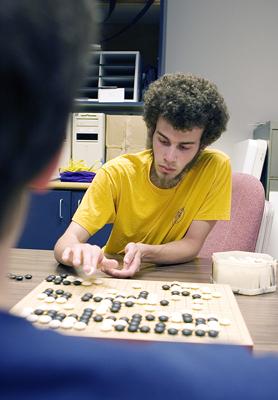If someone asked Liam Royce what the hardest board game is, he will not say chess. Royce will say that it’s “Go,” a board game that originated in Asia, but remains unknown to most Americans. Royce, a senior in paper science and chemical engineering, learned to play Go when he was a senior in high school. When he and friend Nathan Mlot came to N.C. State, they formed the Wolf Go Club. Royce and Mlot walked around campus and finding students that were willing to learn. The Wolf Go Club has only six regular members, with Royce as the president. The club is composed of engineering and computer science majors who enjoy the analytical challenge of Go that, for them, chess doesnÕt offer. The members said they hope the game will catch on. “It’s not hard to learn the game, but it takes practice to get good,” Jeff Hoagland, a sophomore in physics, said. Go is a two player game played on a board (called a gaban) with a 19×19 grid, or 361 points. Each player is designated with a colored stone, white or black, and attempts to gain the most territory on the board, while protecting their stones from capture. “Unlike chess, a player attempts to accumulate plots on the board rather than take away the opponents’ pieces,” Hoagland said.
Complexity involved in the game requires a higher level of strategy, despite the modest instructions.
“The rules of Go are simple, but the variations are billions and billions because the pieces can go into any of the 361 points,” Royce said. Go was created centuries ago in ancient China and has retained its popularity in East Asia. The West has not caught on, save for online games and the appearances of Go in such mainstream films as A Beautiful Mind and Hero or Japanese anime, but Royce said he hopes the Wolf Go Club will offer people the chance to play an exciting new game, which all club members are very willing to teach. The Wolf Go Club meets every Monday from 7-10 p.m. in the SORC office located in Talley Student Center.








